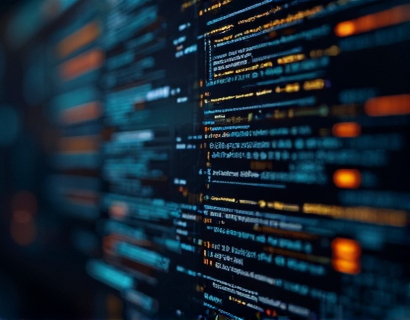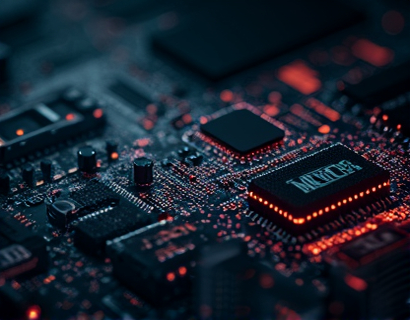Advanced Layer 2 Solutions: Revolutionizing Blockchain Scalability and Efficiency for EVM-Enabled Development
In the rapidly evolving landscape of blockchain technology, scalability and efficiency have emerged as critical challenges for developers, especially those working with Ethereum Virtual Machine (EVM)-enabled platforms. The inherent limitations of Layer 1 blockchains, such as limited transaction throughput and high gas fees, have spurred the development of advanced Layer 2 solutions. These solutions aim to enhance scalability, security, and efficiency, enabling the creation of faster, more secure, and cost-effective decentralized applications (dApps). This article delves into the transformative impact of advanced Layer 2 solutions on EVM-based blockchain development, providing insights for blockchain developers and innovators.
Understanding Layer 2 Solutions
Layer 2 solutions refer to technologies built on top of existing blockchain networks (Layer 1) to improve performance and reduce costs. Unlike Layer 1 upgrades, which involve modifying the core protocol, Layer 2 solutions operate within the existing framework, offloading some of the computational and transactional load. This approach allows for significant improvements in transaction speed and cost without compromising the security and decentralization of the underlying blockchain.
For EVM-enabled development, Layer 2 solutions are particularly valuable. The EVM, while powerful, has limitations in terms of scalability and cost efficiency. By leveraging Layer 2 techniques, developers can create dApps that benefit from the security and trust of the Ethereum network while enjoying enhanced performance characteristics.
Key Layer 2 Techniques
Several advanced Layer 2 techniques have gained prominence in the blockchain community, each offering unique advantages for EVM-based development.
State Channels
State channels allow multiple transactions to be executed off-chain, with only the final state being recorded on the blockchain. This method significantly reduces the number of on-chain transactions, thereby lowering gas costs and increasing transaction speed. For EVM-based dApps, state channels can be particularly beneficial for applications requiring frequent and small transactions, such as gaming or payment systems.
To implement state channels, developers need to establish a secure and trustworthy channel between parties. Transactions are conducted off-chain, and once the channel is closed, the final state is submitted to the blockchain. This approach minimizes the load on the main chain, making it an efficient solution for high-frequency transactions.
Plasma
Plasma is a scalability framework that involves creating a tree-like structure of child blocks attached to the main blockchain. Each child block can process multiple transactions before submitting a summary to the main chain. This hierarchical approach allows for parallel processing and significant increases in transaction throughput.
For EVM-based development, Plasma enables the creation of scalable dApps by offloading transaction processing to child blocks. Developers can design their dApps to utilize Plasma's efficiency, ensuring fast and cost-effective operations while maintaining the security of the main chain.
Optimistic Rollups
Optimistic Rollups bundle multiple transactions into a single transaction on the main chain, with the assumption that all off-chain transactions are valid. If any transaction is found to be invalid, the rollup can be challenged and resolved. This approach provides a balance between scalability and security, making it suitable for a wide range of dApps.
For EVM-based development, Optimistic Rollups offer a robust solution for scaling dApps without sacrificing security. Developers can leverage the efficiency of rollups to create high-performance applications, such as decentralized finance (DeFi) platforms and non-fungible token (NFT) marketplaces.
ZK Rollups
ZK Rollups, or Zero-Knowledge Rollups, use zero-knowledge proofs to bundle and verify transactions off-chain, providing a higher level of security and finality compared to Optimistic Rollups. This method ensures that the final state submitted to the main chain is correct, without revealing the underlying transaction data.
For EVM-based dApps, ZK Rollups offer an excellent combination of scalability and security. Developers can build complex and secure applications, such as decentralized exchanges (DEXs) and yield farming platforms, with confidence in the integrity of the off-chain transactions.
Benefits of Advanced Layer 2 Solutions
The adoption of advanced Layer 2 solutions brings numerous benefits to EVM-based blockchain development, addressing key challenges and unlocking new possibilities.
Enhanced Scalability
One of the most significant advantages of Layer 2 solutions is the dramatic increase in transaction throughput. By processing transactions off-chain and only recording the final state on the main chain, these solutions can handle thousands or even millions of transactions per second. This scalability is crucial for dApps that require high performance, such as social media platforms, gaming environments, and financial services.
Reduced Costs
High gas fees on Layer 1 blockchains have been a persistent issue, deterring widespread adoption and limiting the viability of certain dApps. Layer 2 solutions significantly reduce transaction costs by offloading processing to sidechains or rollups. This cost efficiency makes it more feasible for developers to build and maintain scalable dApps, attracting a broader user base.
Improved User Experience
Faster transaction times and lower fees directly translate to a better user experience. Users can interact with dApps without the frustration of long wait times and exorbitant fees. This improvement is particularly important for user-sensitive applications, such as mobile wallets and real-time gaming, where responsiveness and affordability are paramount.
Maintaining Security and Decentralization
Despite the focus on scalability and cost efficiency, advanced Layer 2 solutions maintain the security and decentralization core to blockchain technology. Techniques like state channels, Plasma, Optimistic Rollups, and ZK Rollups are designed to preserve the integrity of the blockchain while enhancing performance. Developers can trust that their dApps remain secure and decentralized, even as they scale to meet growing demand.
Challenges and Considerations
While advanced Layer 2 solutions offer substantial benefits, developers must also be aware of the challenges and considerations involved in their implementation.
Complexity and Integration
Implementing Layer 2 solutions can introduce additional complexity to dApp development. Developers need to understand the underlying mechanics of techniques like state channels, Plasma, and rollups to integrate them effectively. This requires a deeper technical expertise and careful consideration of compatibility with existing systems.
Security Risks
Although Layer 2 solutions are designed to enhance security, they are not without risks. For instance, state channels rely on the trust between parties, and any breach can lead to significant losses. Similarly, rollups depend on the correctness of the final state submission, and any vulnerabilities in the rollup protocol can be exploited. Developers must thoroughly assess and mitigate these risks to ensure the security of their dApps.
Interoperability
Interoperability between different Layer 2 solutions and Layer 1 blockchains can be challenging. Developers need to ensure that their dApps can seamlessly interact with various Layer 2 layers and maintain consistency across different networks. This requires careful planning and adherence to established standards and protocols.
Future Prospects
The future of blockchain scalability and efficiency is bright, with ongoing innovations and collaborations driving the development of advanced Layer 2 solutions. As the ecosystem matures, we can expect further improvements in performance, security, and user experience.
For EVM-based development, the integration of advanced Layer 2 solutions will continue to play a pivotal role in shaping the next generation of dApps. Developers who embrace these technologies will be well-positioned to create innovative and impactful applications that redefine the possibilities of decentralized computing.
In conclusion, advanced Layer 2 solutions are revolutionizing blockchain scalability and efficiency, particularly for EVM-enabled development. By addressing key challenges and leveraging the strengths of techniques like state channels, Plasma, Optimistic Rollups, and ZK Rollups, developers can build faster, more secure, and cost-effective dApps. As the blockchain landscape evolves, these solutions will remain at the forefront of innovation, driving the future of decentralized technologies.










































